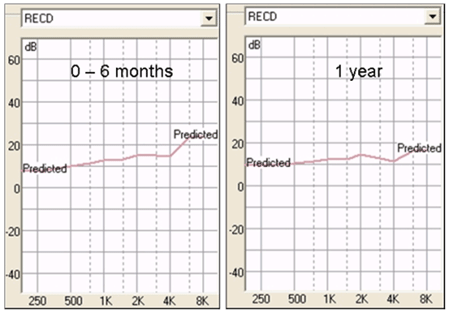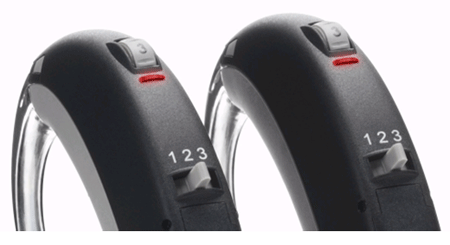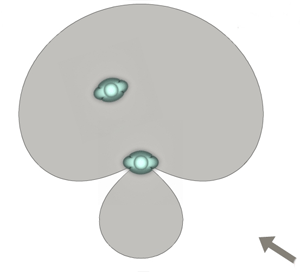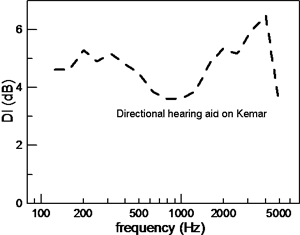Abstract:
Directional hearing aids can improve the signal-to-noise-ratio (SNR) of speech occurring in a noisy background. Amplification of background noise is one of the most significant consumer-based complaints associated with hearing aids. Although other technologies (FM systems, direct audio input, assistive listening devices, etc.) can improve the SNR, directional microphones are the only "hearing aid option" proven to improve speech understanding in noise (Killion, 2004 and Dillon, 2001).
As sophisticated digital signal processing (DSP) hearing instruments developed, additional directional technologies have become available which offer a multitude of unique benefits. This article will offer a brief review of directional hearing aid systems and concepts and will highlight new directional technologies.
Historical Note: The Pre-DSP Era
Directional technology has been available since 1969 (Lybarger and Lybarger, 2000). Oticon released the series 568 hearing aid with directional microphones in 1972. The 568 was available commercially in several models and with multiple modifications (Nielsen, 2005). Early directional hearing aids were essentially large behind-the-ear (BTE) instruments and their directional characteristics depended essentially on physical attributes of the hearing aid itself, and of course, the sound source.
The pressure gradient microphone system (an early directional hearing aid microphone system) available in the late 1960s had two ports within a common microphone. The two microphone ports were spaced approximately 16 mm from each other. If the noise source originated directly behind the wearer, noise would arrive at the rear microphone port first, and approximately 57 microseconds later, the noise would arrive at the front port. The sound entering the rear port was delayed by an amount equal to this travel time. The microphones transmitted the noise to either side of a common diaphragm resulting in the cancellation of vibratory forces from the two ports, for sounds originating in the rear, creating an early "directional" response (Ricketts & Mueller, 1999, Staab, 2002, and Staab & Lybarger, 1994). Dillon (2001A) noted, even omni-directional hearing aids, when placed on the head, take on directional characteristics. The pinna and head shadow effect reduce sounds from the ipsi and contralateral sides, while maximally allowing sounds from the front and rear.
Popularity of Directional Hearing Aids in 2005:
Directional microphones were quite limited, with regard to their application, in analog hearing aids. However, in the early-to-mid-1990's, directional popularity grew with inclusion of directional systems in programmable analog, and later, digital signal processing systems. One of the major benefits of this development was it allowed the user to easily select directional or omni-directional modes, depending on the particular listening situation. Prior to directional use in programmable hearing aids -- the user had extremely limited "user controlled" options. When an early directional hearing aid was acquired, it was essentially directional 100% of the time. By the end of the 1970s, the E24V Oticon directional hearing aid was available with a mic-port cover which allowed the user to select directional or omni modes, by opening or covering a port, thus allowing limited user control regarding directional or omni modes.
Eventually, DSP-based systems emerged and allowed significant improvements related to directionality. In advanced DSP systems, the traditional dual-port directional microphone has been replaced by a design in which two omni-directional microphones are used, with delay and subtraction occurring electronically. This design shift allows more flexibility in setting the characteristics of the microphone, even allowing the time delay (and thus the polar plot) to vary based on environmental conditions.
Strom (2005) noted in the Hearing Review (HR) 2005 Survey that directional use by dispensing audiologists (DAs) has "surged" in the last three years. He reported among DAs, just under 50 percent of all hearing aid fittings involved directional systems. Of the overall dispensing population (hearing instrument specialists and DAs) 36 percent of all fittings were directional, and the expectation is that 45 percent of all fittings will soon be directional.
Kirkwood (2005) reviewed the annual Hearing Journal/Audiology Online Dispenser Survey. Of two important features compared (noise reduction and directional features), directional systems more often exceeded patients' expectations. Kirkwood reported that 59 percent of the time, directional technology met the patients' expectations, and 20 percent of the time, it exceeded expectations.
Traditional Polar Sensitivity Plots:
Polar sensitivity plots are used to represent the sensitivity of a hearing aid to various sounds and sound source locations, as they circle the hearing aid (360 degrees) while generating noise, such as pure-tones or complex sounds. Traditional Polar Plots have previously defined the expectations of the manufacturer, professional and consumer, with regard to a given hearing aid's response to sound from 360 degrees, to indicate the directional emphasis of the hearing instrument.
However, in 2005 and beyond, directional characteristics using DSP control are more dynamic and are environmentally adaptive. Therefore, new approaches to the quantification of this adaptive behavior are emerging.
Polar Plot Review:
The three primary traditional fixed polar sensitivity plots are the omni-directional, cardioid and the supercardioid. However, there are many variations on these traditional fixed polar plots.
Omni-Directional:
An omni-directional polar plot treats all sounds from all points around the circle as equals. As demonstrated in Figure 1, it does not attenuate sound based on directional characteristics.

Cardioid:
The cardioid response pattern is sometimes described as a heart (cardiac) shape with the point of the heart facing forward (0 degrees azimuth) and with a large null in the rear (see Figure 2). The cardioid is "theoretically" the ideal polar plot when the signal of interest originates from the front, while background noise originates essentially from the rear. This response pattern would maximally amplify speech sounds from the front. Unfortunately, in the real world, it is rare for the signal of interest (i.e., speaker) to be entirely in front of the hearing aid, while at the same time, all environmental and competing noise is from the rear. Generally speaking, noise is much more diffuse and rarely comes only from the rear. In addition, when a directional microphone is worn in situ, response becomes more complex due to the presence of the pinna, head shadow and body effects.

Hypercardioid:
The hypercardioid polar plot is similar to the cardioid, except it has a small extra "lobe" in the rear. With respect to the 0 degree azimuth located in front of the hearing aid, hypercardioid patterns maximally attenuate sound at 130 and 230 degrees, while allowing slight amplification for sounds arriving from 180 degrees, directly behind the hearing aid (Figure 3). This response is better suited to in situ use, since the null is better preserved.

Low Frequency Trade Off:
An inherent property of directional microphones is the roll-off of the low frequency response. The amount of roll-off is inversely proportional to the proximity of the two microphone ports. Because the wavelength of lower frequencies can exceed the distance between the two microphone ports, the phase difference between the ports becomes very small and the resultant sensitivity of the directional microphones falls off sharply for low tones (Knowles). Therefore, low frequency gain is sometimes automatically restored, partially or fully, when directional systems are engaged.
Directivity Index (DI):
An important metric with respect to directional hearing aids is the "Directivity Index," which is expressed in dB. The Directivity Index (DI) compares sounds originating in front, to sounds originating from all other locations around the hearing aid (Figure 4). The DI might be thought of as the difference in dB from an omni-direction microphone and a directional microphone placed in the exact same diffuse acoustic field (Knowles). The higher the DI number, the more "directional" the response of the hearing aid, and the better the wearer is expected to do in a diffuse noisy environment while wearing the hearing aid. Omni-directional hearing aids will theoretically have a DI value of approximately "0" while an extraordinary directional hearing aid might have a DI that approaches 5 or 6. The theoretical maximum DI for a two-microphone array (or 1st order directional mic) is 6 dB (see Laugesen, personal communication, see Elko, 2000, see Dittberner, 2003)
Articulation Index-Directivity Index (AI-DI):
The Articulation Index-Directivity Index (AI-DI) is a refinement of the DI. The AI-DI is a compilation score which uses the articulation index (known also as the Speech Intelligibility Index) spectral weightings, applies them to the DI, to create a more "real-world" measure of directivity, with respect to speech sounds. The AI-DI produces a single number reflecting the anticipated benefits of a directional system specifically with respect to speech sounds, in a realistic acoustic environment. For example, the AI-DI for the response shown in Figure 4 is 4.7 dB.

Dillon (2001) pointed out that each dB of improvement (lowering of noise level) in AI-DI, results in increased sentence-based speech understanding of approximately 10 percent. Of course, the exact conversion is not necessarily 1 dB AI-DI = 10 percent improvement in speech recognition. Speech recognition will vary with type and degree of hearing loss, the background noise and other factors, yet this approximation helps define the very real perceptual benefit possible from an improved signal-to-noise ratio.
Directionality in DSP Systems:
Sophisticated DSP algorithms increase alternatives, options and the potential directional benefit for the wearer. There have been three important improvements mediated by digital signal processing, with respect to directional systems:
- Adaptive Directional Systems:As noted above, the shape of the polar plot is determined by the time delay imposed on signals entering the rear port compared to the front port. In adaptive directional systems, the time delay is constantly varied to apply the polar plot that maximally reduces the sound levels from the sides and rear. This ability maximizes the effectiveness of the noise attenuation of the system.
- Automatic Mode Switching: Until the last few years, the decision regarding directional or omni mode of operation was chosen by the user; flipping a switch or pushing a button, to toggle between directional or omni modes. With advanced systems, automatic mode switching is managed effectively by the device itself. Certain characteristics of the environment are monitored (such as overall level, temporal and spectral characteristics of the environment, etc.) and the device transitions in and out of directionality, based on the nature of the input sound.
Most recently, as implemented in Oticon's Syncro and Tego products, the decision as to directional mode is based on an analysis of the outcome of the signal processing, as compared to typical predictions based on the input signal. The directional mode decision is based on a test of the modulation characteristics of the output in the various possible modes (3 in Syncro, 2 in Tego). The mode which provides a more modulated signal (presumably indicating a better S/N) is chosen.
Walden et al. (2004) noted a unique set of circumstances must be operational for patients to prefer the directional mode. Directionality is not always desired when the input signal is high or whenever speech is present. Rather, Walden et al. (2004) indicated that for directional to be preferred, speech must be present from the front, and nearby, and noise must arise from a direction other than the front. Systems that base the decision to shift into directional exclusively on overall input level will select directional even if no speech is present, or if both speech and noise come from the front, or when speech is coming from behind.
- Multi-band Directionality: The most recent directional systems employ multiple, independent, directional systems in different frequency regions, allowing multiple sources of simultaneous noise to be attenuated. For example, if the dominant noise source in the low frequencies originates from one direction, while a second competing noise source in mid-or-high frequencies originates from another, Syncro can provide different, optimized polar responses in multiple frequency regions to maximally attenuate both noise sources simultaneously.
Syncro and Tego multi-band directionality allow low frequencies to be maintained in omni-directional mode to preserve loudness and sound quality, while allowing directional responses in mid and high frequencies. This split mode possibility improves the patient acceptance of the sound quality of the system and allows directionality in a broader range of situations.
Venting in Directional Systems:
An important advancement in hearing aid technology has been the increasing use of open fittings, secondary to effective feedback cancellation systems. It is important to recognize that directionality can be used with large or open vents in nearly all situations. Open fittings provide a significant, although not usually complete, loss of gain in the lower frequencies. However, most modern directional systems have a response that emphasizes directionality in the mid and high frequencies to maximize the AI-DI. Recent work by Flynn and Lunner (2004) demonstrated all directional benefits were maintained with the Syncro hearing aid, despite large venting.
Directional Trends in 2005:
Hearing aid manufacturers are providing more sophisticated versions of directional technology - the only technology available in hearing aids which has been proven to improve the SNR, while facilitating better understanding of speech in noise.
The positive trends evidenced in the Hearing Review and Hearing Journal 2005 surveys (see above) bode well for consumers, professionals and the industry. It is apparent we have turned the corner on DSP, as we embrace proven technology and further develop concepts that work to dynamically improve the signal-to-noise ratio.
Please Note: An earlier version of this article was provided by Oticon to audiology graduate students as a special supplement to the Hearing Journal, September, 2005.
References:
Dittberner, A.B. (2003). Misconceptions when estimating the directivity index for directional microphone systems on a mankin. International Journal of Audiology, 42(1), 52-54.
Dillon, H. (2001). Hearing aids: A comprehensive text. New York: Boomerang Press and Thieme. Pg 188.
Dillon, H. (2001A). Hearing aids: A comprehensive text. New York: Boomerang Press and Thieme. Pg. 26.
Elko, G.W. (2000). Superdirectional microphone arrays. In S.L. Gay & J. Benesty (Eds.), Acoustic signal processing for telecommuncation, (Chapter 10, pp. 181-237). Kluwer Academic Publishers.
Flynn, M. C. & Lunner, T. (2005). Clinical verification of a hearing aid with artificial intelligence. The Hearing Journal, 58 (2), 34-38.
Killion, M.C. (2004). Myths about hearing in noise and directional microphones. The Hearing Review, 11(2).
Kirkwood, D.H. (2005). Dispensers surveyed on what leads to patient satisfaction. Hearing Journal, 58(4), 19-22.
Knowles Electronics. Directional microphone applications, Knowles Application Note AN-4. Issue 01-0201.
Laugesen, S. (September, 2005). Oticon Research Center, Eriksholm, Denmark.
Personal communication with Douglas L. Beck.
Lybarger, S.F. & Lybarger, E.H. (2000). A historical overview. In R. Sandlin (Ed.), Textbook of hearing aid amplification: Technical and clinical considerations, 2nd edition. San Diego, California: Singular Thomson Learning.
Nielsen, Claus (September, 2005). Oticon Research Center, Eriksholm, Denmark.
Personal communication with Douglas L. Beck.
Ricketts, T. & Mueller H.G. (1999). Making sense of directional microphones. American Journal of Audiology, 8, 117-126.
Staab, W.J. (2002). Characteristics and use of hearing aids. In J. Katz, Handbook of clinical audiology, 5th Edition. Baltimore, Maryland: Lippincott, Williams and Wilkins. Pg. 631-686.
Staab, W.J. & Lybarger, S.F. (1994). Characteristics and use of hearing aids. In J. Katz, Handbook of clinical audiology, 4th Edition. Baltimore, Maryland: Lippincott, Williams and Wilkins.
Strom, K.E. (2005). The HR 2005 dispenser survey. The Hearing Review, (12)6, 18-72.
Walden, B., Surr, R., Cord, M. & Drylund, O. (2004). Predicting hearing aid microphone preference in everyday listening. Journal of the American Academy of Audiology, 15, 353-364.



